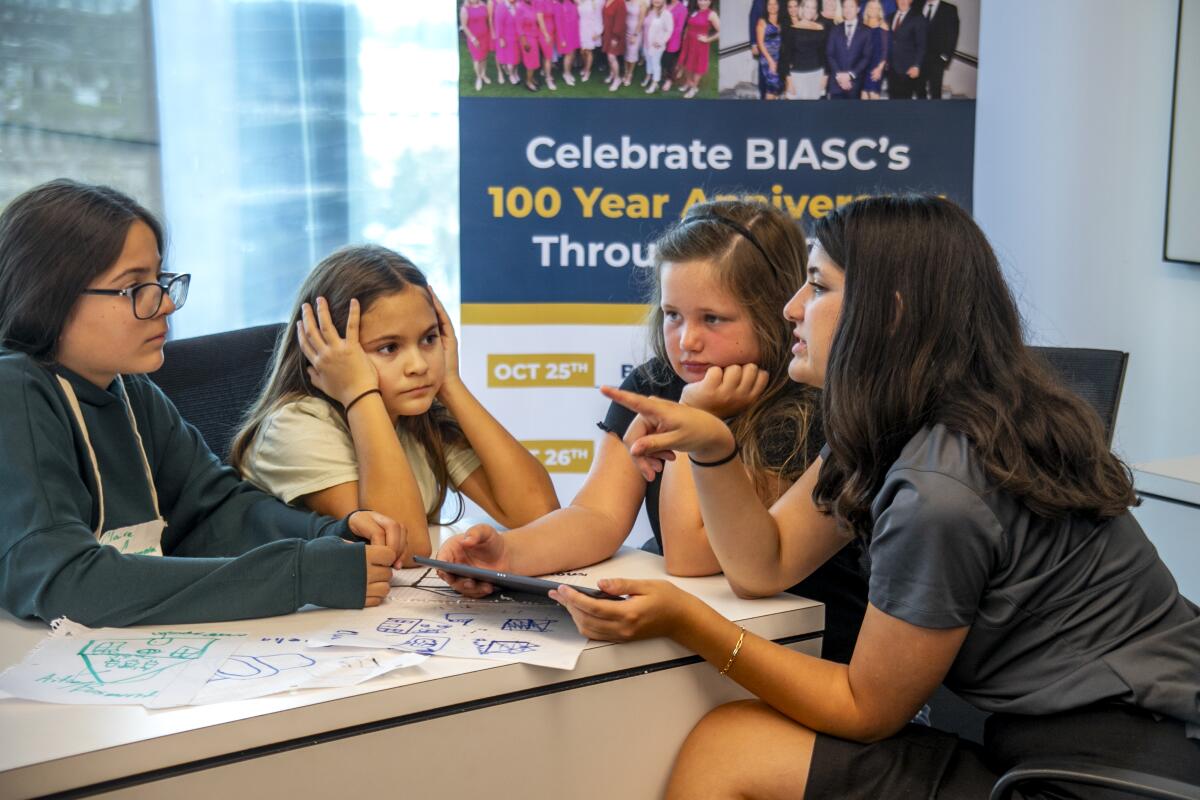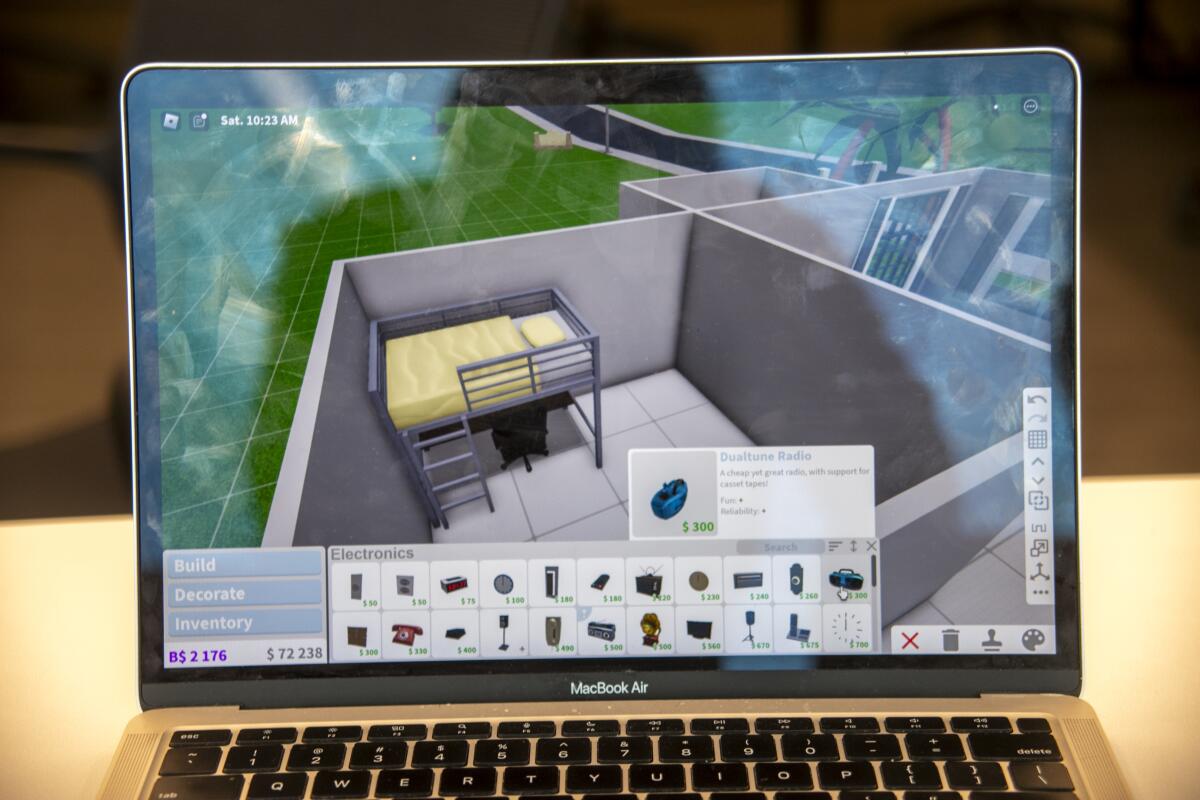Building association camp aims to develop interest in the industry among digital natives

- Share via
One might expect to see kids at a builder’s camp swinging hammers at nails, but on Wednesday enrollees in a Junior Builders Camp, hosted by the Building Industry Assn. of Southern California, were busy not at work sites but websites.
During a three-day discovery camp designed to spark an interest in the design-build process, a group of would-be contractors ages 9 to 13 got a chance to tour a construction site, talk with leaders in the industry and try their own hand at making homes happen.
BIASC Chief Executive Jeff Montejano said his young daughters Mia and Maddie came up with the idea for a camp after realizing there were no recreational or school opportunities for young kids to learn more about the building industry.

“[Mia] said, ‘Dad, I can do soccer or jujitsu — why can’t I build?” the executive recalled Wednesday. “They wanted to get involved, and I had no way for them to get involved. There was no child component to it.”
After some brainstorming, the first Junior Builders Camp opened in 2019, mainly for children of BIASC members. After a pandemic interruption, activities resumed last year, when young campers got a chance to design, construct, decorate and ride on a float in the 2023 Rose Parade.
These days Mia, a 16-year-old rising sophomore at San Clemente High School, helps her dad by working directly with campers, whether the format is an all-day affair or broken up into shorter sessions over multiple days.
“At first, parents were really confused, because nobody had heard of it,” she said of the early days. “And an 11-year-old me was like, ‘It’s fun — I’m 11 and I like it, so your kids should like it. It’s been five years now and we’ve had so many camps since then.”

On Monday and Tuesday, campers got a chance to talk with builders and developers, try their own hand at drafting designs for a dream home they would later create with teammates and tour a construction site with model homes being built in Tustin by Brookfield Residential, a sponsor of the camp.
Foregoing work boots and hard hats for attire befitting the ninth floor of Brookfield’s Costa Mesa office suite, campers Wednesday formed into three teams to participate in a design contest.
Small groups huddled over laptops and iPads to create virtual homesteads using the online game Roblox, a virtual universe where users can design their own structures and fill them with features that characters, or avatars, can use and enjoy on screen.

Although the three teams were given a budget, the only limits to the project were their own imaginations. Each team was to be judged based on its overall design, collaboration, presentation and creativity.
Mission Viejo rising fourth-grader Maryn Knecht worked as part of the all-girl team “The Majestic Flushers,” which was busy creating a party pad complete with an outdoor climbing wall that led to a rooftop swimming pool.
The 9-year-old daughter of a Brookfield employee, Maryn was competing against 13-year-old brother Michael, who’d helped build the BIASC Rose Parade float last year and was busy Wednesday installing a moat and basketball court in his team’s dream home.
“My brother did it last year, and I wanted to do it,” she said. “I thought building was really fun, and finding people homes was really important. Plus, I come to my mom’s office every day, and I really like it here.”

Joseph Jimenez, a 9-year-old Santa Ana resident and member of the team Diller Pillars, said he heard about the camp from his mom, who’d talked with Mia.
“She told me about the program, and I figured it was neat so I joined it,” he said, adding that the use of Roblox, a favorite online platform of his, was a draw. “We’ve made houses and are just building stuff with our minds and creativity.”

Although he’s not sure yet about a job in the building industry, Joseph said he enjoyed the creativity of the design process.
While several campers are the children of BIASC members or Brookfield Residential employees, Junior Builders Camp has more recently widened its reach by partnering with schools and organizations that serve underserved youth to create an array of program options.
Montejano said the idea is to give kids more exposure to the variety of career opportunities in the building industry while, at the same time, inspiring digital natives to potentially revolutionize the way projects are imagined and built.
“We currently have a labor shortage. Our employee population is aging, and we’re not getting a lot of new people in,” he said. “By promoting the industry at a young age, we can attract a new generation of builders.
“I would say, with the technology in the next five to 10 years, these kids are going to have a jump on the current workforce.”
All the latest on Orange County from Orange County.
Get our free TimesOC newsletter.
You may occasionally receive promotional content from the Daily Pilot.




